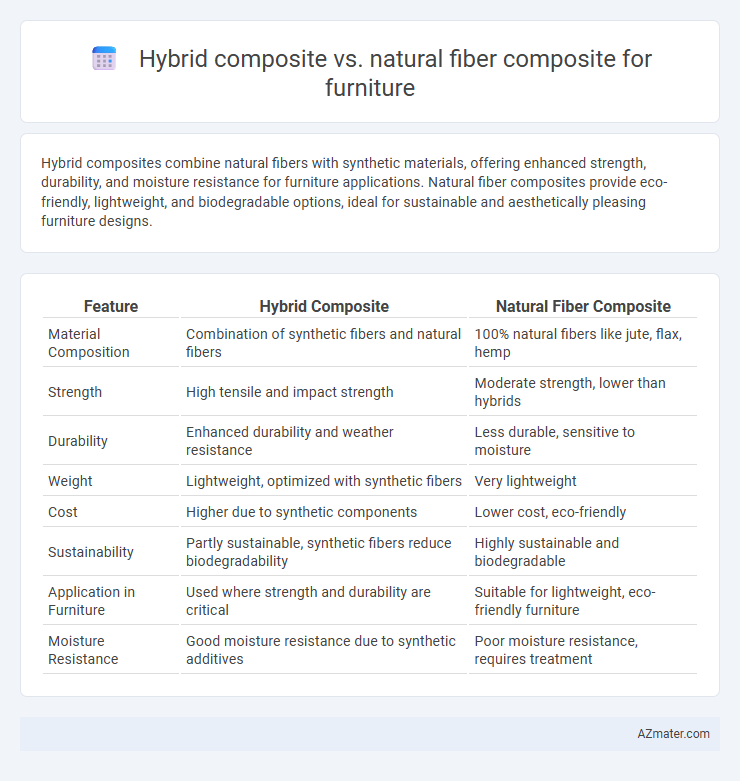Hybrid composites combine natural fibers with synthetic materials, offering enhanced strength, durability, and moisture resistance for furniture applications. Natural fiber composites provide eco-friendly, lightweight, and biodegradable options, ideal for sustainable and aesthetically pleasing furniture designs.
Table of Comparison
| Feature | Hybrid Composite | Natural Fiber Composite |
|---|---|---|
| Material Composition | Combination of synthetic fibers and natural fibers | 100% natural fibers like jute, flax, hemp |
| Strength | High tensile and impact strength | Moderate strength, lower than hybrids |
| Durability | Enhanced durability and weather resistance | Less durable, sensitive to moisture |
| Weight | Lightweight, optimized with synthetic fibers | Very lightweight |
| Cost | Higher due to synthetic components | Lower cost, eco-friendly |
| Sustainability | Partly sustainable, synthetic fibers reduce biodegradability | Highly sustainable and biodegradable |
| Application in Furniture | Used where strength and durability are critical | Suitable for lightweight, eco-friendly furniture |
| Moisture Resistance | Good moisture resistance due to synthetic additives | Poor moisture resistance, requires treatment |
Introduction to Composite Materials in Furniture
Composite materials in furniture combine two or more distinct constituents to enhance mechanical properties, durability, and aesthetic appeal. Hybrid composites integrate synthetic fibers with natural fibers, such as glass or carbon coupled with hemp or jute, improving strength and resistance while maintaining eco-friendliness. Natural fiber composites utilize fibers like flax, sisal, or coir bonded with bio-based resins, offering lightweight, sustainable alternatives with lower environmental impact compared to traditional materials.
Overview of Hybrid Composites
Hybrid composites combine natural fibers like jute or hemp with synthetic fibers such as glass or carbon to enhance mechanical properties and durability for furniture applications. These composites offer improved strength, stiffness, and impact resistance compared to natural fiber composites alone, making them suitable for load-bearing and high-use furniture components. The synergy between natural and synthetic fibers also provides a balance of sustainability, cost-effectiveness, and performance, addressing limitations found in purely natural fiber composites.
Overview of Natural Fiber Composites
Natural fiber composites for furniture utilize fibers such as jute, flax, hemp, and sisal embedded in polymer matrices, offering renewable and biodegradable alternatives to synthetic materials. These composites provide advantages including lightweight properties, good mechanical strength, and improved acoustic insulation, making them ideal for sustainable furniture applications. However, their moisture absorption and lower durability compared to hybrid composites require careful treatment and design considerations.
Material Properties Comparison
Hybrid composites combine natural fibers with synthetic fibers, offering enhanced mechanical strength, durability, and moisture resistance compared to natural fiber composites alone. Natural fiber composites are lightweight, biodegradable, and provide good thermal insulation but often exhibit lower tensile strength and higher water absorption. The hybrid composite's improved impact resistance and structural integrity make it more suitable for furniture applications requiring long-term performance and environmental resilience.
Environmental Impact and Sustainability
Hybrid composites used in furniture combine synthetic and natural fibers, offering enhanced durability but often increasing environmental impact due to non-biodegradable components. Natural fiber composites, derived from renewable resources like hemp or flax, provide superior sustainability by reducing carbon footprint and promoting biodegradability. Selecting natural fiber composites supports eco-friendly furniture manufacturing with lower emissions and improved end-of-life recyclability.
Performance in Furniture Applications
Hybrid composites, combining synthetic fibers like glass or carbon with natural fibers, deliver enhanced mechanical strength, durability, and moisture resistance compared to pure natural fiber composites, making them well-suited for high-load furniture components. Natural fiber composites, primarily composed of materials such as hemp, jute, or flax, offer eco-friendly benefits and adequate performance in lightweight furniture applications but generally exhibit lower impact resistance and dimensional stability. The hybrid approach optimizes performance by leveraging the superior tensile strength and stiffness of synthetic fibers while maintaining sustainability advantages, leading to furniture with improved longevity, aesthetic flexibility, and structural reliability.
Design Flexibility and Aesthetic Options
Hybrid composites offer superior design flexibility and a wider range of aesthetic options compared to natural fiber composites, enabling intricate shapes and customizable finishes ideal for modern furniture. The blend of synthetic and natural fibers in hybrid composites enhances surface smoothness and color consistency, facilitating diverse textures and patterns that meet contemporary interior design trends. Natural fiber composites, while eco-friendly, often present limitations in uniformity and structural adaptability, restricting complex design possibilities and aesthetic variations in furniture production.
Cost Efficiency and Market Trends
Hybrid composites combine synthetic and natural fibers, offering enhanced durability and lower production costs compared to pure natural fiber composites in furniture manufacturing. Natural fiber composites attract eco-conscious consumers due to biodegradability and sustainability, but often incur higher material and processing expenses. Market trends show growing demand for cost-effective hybrid composites amid increasing preference for environmentally friendly yet affordable furniture solutions.
Challenges and Limitations
Hybrid composites in furniture face challenges such as higher production costs and complexity in manufacturing due to combining synthetic and natural fibers, which can affect consistency and performance. Natural fiber composites, while eco-friendly and lightweight, encounter limitations including lower moisture resistance, reduced mechanical strength, and variability in fiber quality that compromise durability. Both materials require advanced treatments and design optimization to overcome issues like poor bonding and environmental degradation for effective furniture applications.
Future Prospects in Furniture Manufacturing
Hybrid composites, combining synthetic fibers with natural fibers, offer enhanced mechanical properties and durability, making them highly promising for future furniture manufacturing. Natural fiber composites are gaining traction due to their sustainability, biodegradability, and cost-effectiveness, aligning with increasing consumer demand for eco-friendly furniture. Advancements in manufacturing technologies and material science are expected to further optimize the performance of both hybrid and natural fiber composites, driving innovation and broader adoption in the furniture industry.

Infographic: Hybrid composite vs Natural fiber composite for Furniture
 azmater.com
azmater.com